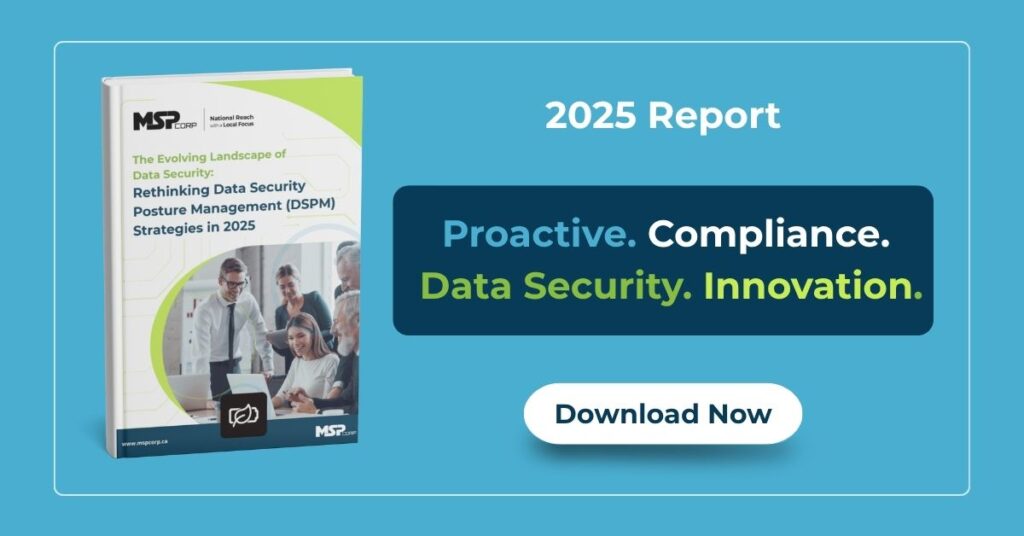Canada’s digital landscape is expanding rapidly.
By 2025, the country’s Information and Communications Technology (ICT) market is projected to reach $132.6 billion. This growth is expected to be driven mainly by investments in cloud computing, cybersecurity, and data management. As Canadian organizations generate and store more data, protecting sensitive information has become increasingly critical.
This is where tools like Data Loss Prevention (DLP) and Data Security Posture Management (DSPM) come in. Both are critical to protecting data, yet they solve different problems and operate in different ways.
In this article, we’ll explore the differences between DLP and DSPM, why each matter and how they can work together to create a stronger data security strategy.
What is DLP?
Data Loss Prevention (DLP) is a security solution that identifies, monitors, and protects sensitive data from unauthorized access, sharing, or exfiltration. It enforces security policies across emails, endpoints, cloud applications, and networks, helping organizations prevent leaks and maintain compliance.
According to IBM’s 2025 Cost of a Data Breach Report, Canadian organizations are experiencing a significant rise in breach-related expenses. The average cost of a data breach in Canada has increased to CA$6.98 million, marking a 10.4% rise from the previous year. This uptick underscores the growing financial impact of security incidents on Canadian businesses.
In this section, we will explore:
- The core features of DLP, including how it monitors, controls, and safeguards sensitive information in multi-provincial operations.
- The benefits it delivers, including risk reduction, regulatory compliance, and supporting federal and provincial privacy obligations.
- The challenges and blind spots of DLP, including its reactive focus and operational limitations.
- Common real-world use cases, such as preventing unauthorized file sharing or cloud uploads.
Core Features of DLP
- Content scanning: examines files, emails, and messages to detect sensitive information such as personal identifiers, financial records, health data, or proprietary business assets, important for sectors like healthcare, banking, and education that must comply with PIPEDA and provincial privacy regulations.
- Policy-driven enforcement: Applies predefined security rules that govern how sensitive data can be accessed, shared, or transferred within and outside the organization.
- Preventive safeguards: Uses techniques such as blocking, quarantining, or encrypting data to stop unauthorized transfers before they occur, protecting organizations from both internal and external threats.
- Regulatory alignment: Supports compliance with major data protection laws in multiple regions. In Canada, this includes privacy requirements across federal and provincial laws:
-
Federal:
PIPEDA (Personal Information Protection and Electronic Documents Act) applies across Canada where no equivalent provincial law exists
-
Québec:
Law 25 (formerly Bill 64) introduces strict consent rules, privacy impact assessments, and significant financial penalties for non-compliance.
-
Alberta:
Personal Information Protection Act (PIPA) regulates how businesses manage personal information within the province.
-
British Columbia:
PIPA (BC) applies to private-sector organizations, with requirements similar to Alberta’s law.
-
Other provinces and territories
Default to federal PIPEDA.
-
Emerging federal regulation Bill C-8:
This new legislation, once passed, may expand obligations around data protection, incident reporting, and oversight. Click on the title to learn more about its implications: MSP Corp’s Bill C-8 resource.
DLP solutions can help organizations streamline compliance across multiple provinces, particularly for enterprises with offices or clients across Canada. Learn more about enhancing compliance with DLP solutions.
The Benefits of DLP
- Risk reduction: Minimizes the likelihood of accidental or intentional data exposure.
- Regulatory compliance: Assists in meeting federal and provincial privacy obligations, reducing the risk of fines and reputational damage.
- Data visibility: Provides insight into how personal and sensitive information moves across the enterprise, helping multi-provincial organizations identify vulnerabilities.
Challenges of DLP
- Reactive focus: DLP prevents data leaks but does not address overall security posture or long-term risks.
- Policy maintenance: Rules require constant updates and fine-tuning to reduce false positives and operational friction.
- Limited coverage: DLP is effective for controlling leaks but does not provide comprehensive risk assessments or recovery capabilities for complex multi-cloud environments.
Common Use Cases For DLP
- Preventing employees from sending sensitive files outside the organization.
- Blocking unauthorized uploads to personal or unapproved cloud storage.
- Enforcing redaction of personal information in documents shared externally to comply with federal or provincial privacy legislation.
- Ensuring compliance for organizations handling regulated data across multiple provinces, such as banks, universities, or healthcare providers.
DLP remains a cornerstone of modern data protection strategies. However, it is not a complete solution. As environments become more complex and attackers more sophisticated, organizations need visibility that goes beyond reactive safeguards. A proactive approach is required to continuously assess risks, strengthen security posture, and support rapid recovery. This is where Data Security Posture Management (DSPM) adds critical value. This is where Data Security Posture Management (DSPM) adds critical value.
What is DSPM?
Data Security Posture Management (DSPM) is a proactive, risk-based approach to protecting sensitive information across cloud and hybrid environments. Unlike traditional DLP, which primarily controls data movement, DSPM gives organizations full visibility into their security posture, detects vulnerabilities, and enables teams to mitigate risks before breaches occur.
In Canada, the ICT sector is experiencing significant growth, with over 48,700 companies, predominantly in software and computer services, contributing to a robust digital economy. This expansion underscores the need for advanced data security strategies like DSPM.
In this section, we will cover:
- The key features of DSPM, including automated discovery, risk-based analysis, and proactive controls.
- The benefits it offers, from full-spectrum security to adaptability against evolving threats.
- Challenges organizations may face, such as initial configuration and ongoing maintenance.
- Common use cases, showing where DSPM delivers measurable impact.
- How DLP fits within a DSPM-driven strategy, creating a comprehensive security framework.
Key Features of DSPM
- Automated data discovery: Continuously scans and classifies sensitive information across structured and unstructured sources, helping Canadian organizations comply with federal (PIPEDA) and provincial privacy laws (e.g., Québec’s Law 25, Alberta PIPA, BC PIPA) while reducing blind spots.
- Risk-based analysis: Detects misconfigurations, excessive permissions, and policy violations to strengthen security posture in multi-cloud and hybrid environments commonly used by Canadian SMBs and enterprises.
- Proactive security controls: Generates alerts, actionable recommendations, and automated remediation for potential threats, addressing the growing cybersecurity threats facing Canadian businesses.
- Continuous monitoring and compliance: Aligns data policies with Canadian regulatory frameworks, while adapting to changing risk conditions across provinces and industry sectors.
- Resilience and recovery: Supports rapid response and recovery in the event of data compromise or loss, critical for sectors like finance, healthcare, and education in Canada.
Benefits of DSPM
- Comprehensive coverage: Provides visibility, prevention, risk management, and recovery for end-to-end data security across Canadian organizations.
- Automated risk detection: Identifies gaps in compliance and security without relying solely on manual policy creation, helping meet provincial and federal audit requirements.
- Adaptability to evolving threats: Dynamically adjusts to new risks, which is essential for Canadian businesses navigating increasingly sophisticated cyber threats.
Challenges of DSPM
- Initial setup: Fine-tuning configurations to match specific organizational needs requires effort.
- Ongoing maintenance: Regular updates and adjustments are necessary to ensure the solution remains effective against emerging threats and to stay aligned with evolving Canadian privacy laws.
Common Use Cases For DSPM
- Discovering shadow or orphaned data across multi-cloud environments.
- Detecting unauthorized or overprivileged access to sensitive information, especially personal data protected under PIPEDA or provincial privacy legislation.
- Automating remediation for misconfigurations or policy violations.
The Strategic Advantage of DSPM
While DLP provides critical protection against data leaks, it is inherently reactive and limited in scope. DSPM bridges this gap, offering a holistic strategy that includes proactive risk management, continuous monitoring, and robust recovery capabilities. By integrating DLP as a tactical control within a DSPM-driven strategy, organizations can achieve comprehensive security that adapts to modern threats, maintains regulatory compliance, and protects data across its entire lifecycle
Conclusion
For Canadian SMBs navigating increasingly complex data environments, relying on DLP alone is no longer enough. Combining DLP with DSPM gives organizations the visibility, control, and resilience required to proactively manage risks and protect sensitive information. MSP Corp recommends a layered approach: use DLP to prevent immediate leaks, while leveraging DSPM to gain full oversight, continuously reduce exposure, and ensure long-term data security.
For more information on how MSP Corp can assist with your data security needs, contact us at cybersecurity@mspcorp.ca.


